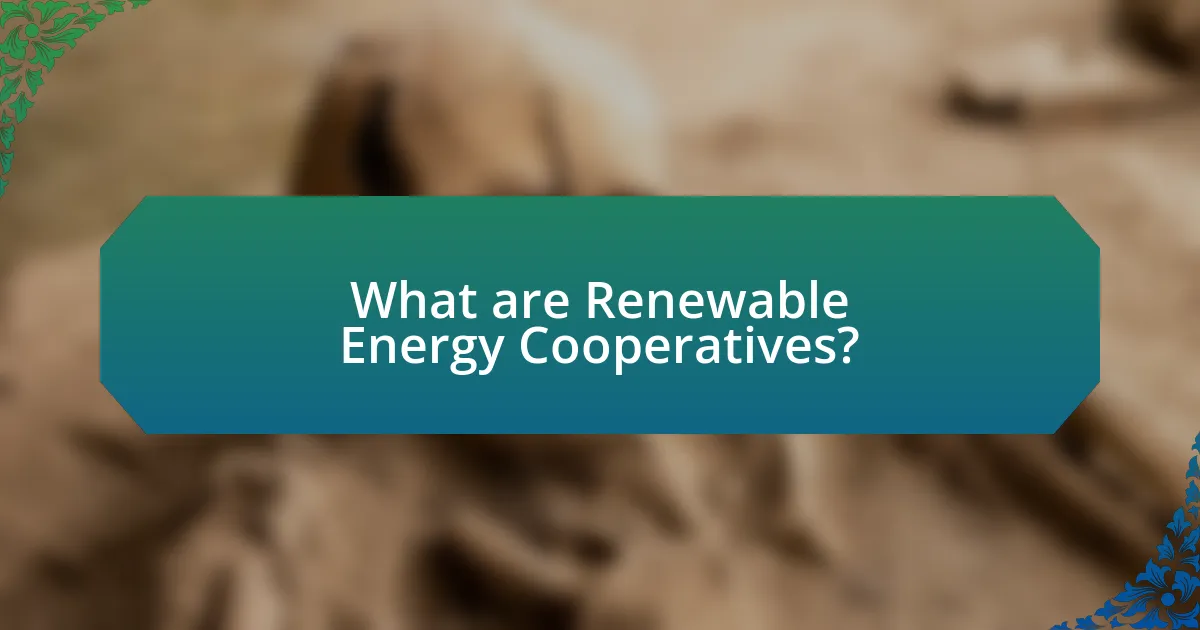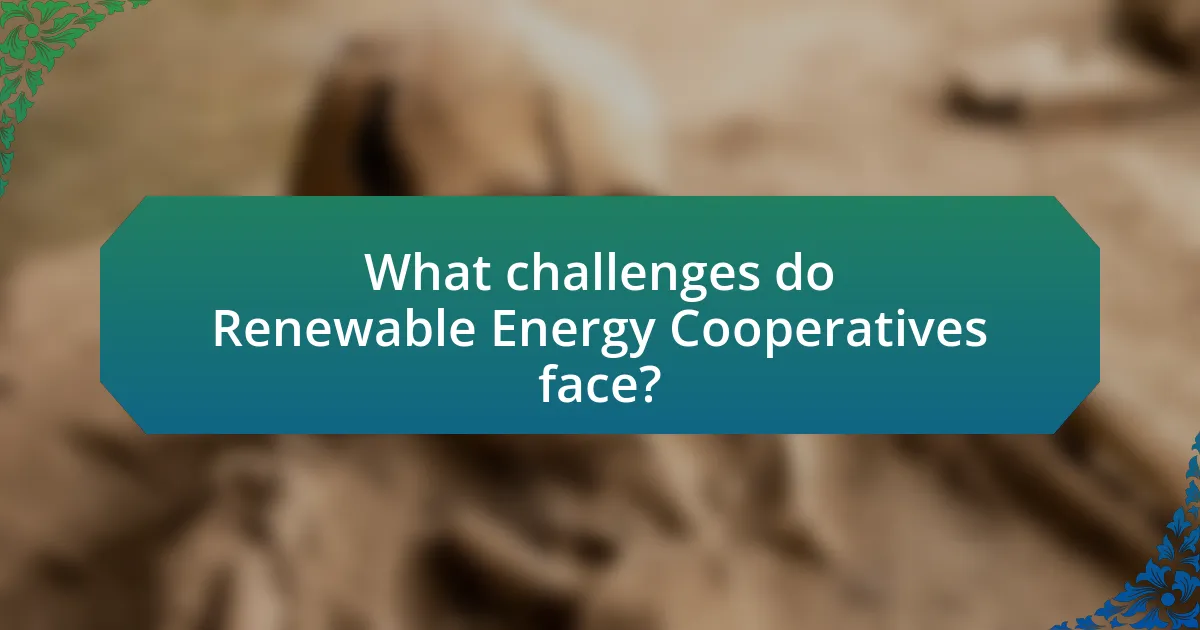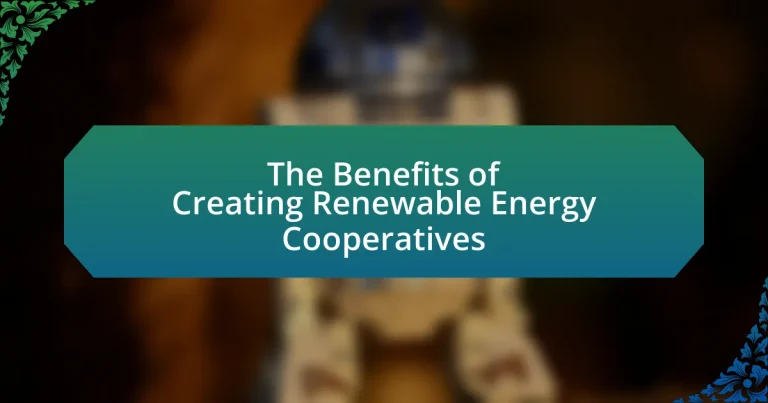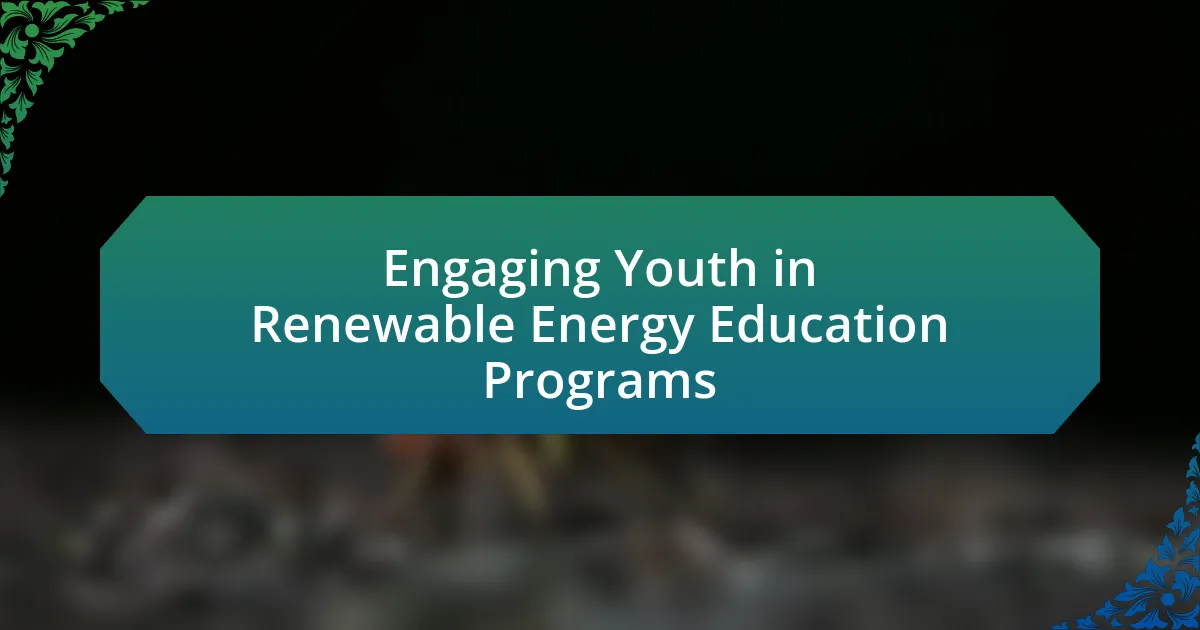Renewable energy cooperatives are member-owned organizations that facilitate the production and distribution of renewable energy, such as solar and wind power. They operate by pooling resources from members to develop and manage energy projects, promoting local energy independence and economic benefits. Key components include member ownership, democratic governance, and a focus on sustainability, which enhance community resilience and engagement. These cooperatives play a crucial role in the transition to sustainable energy by reducing reliance on fossil fuels, lowering energy costs, and contributing to local economies while also addressing challenges such as financing and regulatory hurdles. The article outlines the benefits of creating renewable energy cooperatives, their operational mechanisms, and strategies for overcoming challenges to ensure their success.

What are Renewable Energy Cooperatives?
Renewable energy cooperatives are member-owned organizations that facilitate the production and distribution of renewable energy, such as solar or wind power. These cooperatives enable individuals and communities to collectively invest in renewable energy projects, thereby increasing access to sustainable energy sources. According to the National Renewable Energy Laboratory, cooperative models can enhance local energy resilience and promote economic benefits by keeping energy investments within the community.
How do Renewable Energy Cooperatives operate?
Renewable Energy Cooperatives operate by pooling resources and investments from members to develop and manage renewable energy projects, such as solar or wind farms. Members typically buy shares in the cooperative, which provides them with a stake in the energy production and profits generated. This model allows for collective decision-making and shared benefits, fostering community engagement and local economic development. According to the International Cooperative Alliance, cooperatives can enhance energy security and promote sustainable practices by enabling communities to control their energy sources and reduce reliance on fossil fuels.
What are the key components of a Renewable Energy Cooperative?
The key components of a Renewable Energy Cooperative include member ownership, democratic governance, shared financial benefits, and a focus on sustainable energy production. Member ownership ensures that individuals have a stake in the cooperative, promoting engagement and commitment. Democratic governance allows members to participate in decision-making processes, typically through one-member-one-vote systems, fostering equality and transparency. Shared financial benefits, such as profit distribution and reduced energy costs, incentivize participation and investment. Lastly, a focus on sustainable energy production aligns the cooperative’s goals with environmental stewardship, often utilizing renewable sources like solar, wind, or biomass. These components collectively enhance community resilience and promote local economic development.
How do members participate in a Renewable Energy Cooperative?
Members participate in a Renewable Energy Cooperative by investing in the cooperative, which allows them to collectively own and manage renewable energy projects. This participation typically involves purchasing shares or membership stakes, which grants them voting rights in decision-making processes regarding project development, energy production, and distribution. Additionally, members may engage in activities such as attending meetings, contributing to community outreach, and sharing in the profits generated from energy sales. According to the National Renewable Energy Laboratory, cooperatives empower local communities by enabling them to have a direct stake in sustainable energy initiatives, fostering both economic and environmental benefits.
Why are Renewable Energy Cooperatives important?
Renewable Energy Cooperatives are important because they empower communities to take control of their energy production and consumption. By pooling resources, members can invest in renewable energy projects, leading to increased local energy independence and reduced reliance on fossil fuels. Studies show that cooperatives can lower energy costs for members by providing access to affordable renewable energy sources, such as solar and wind. Additionally, they promote sustainable practices and contribute to local economies by creating jobs in the renewable energy sector.
What role do they play in the transition to sustainable energy?
Renewable energy cooperatives play a crucial role in the transition to sustainable energy by enabling local communities to collectively invest in and manage renewable energy projects. These cooperatives empower individuals to participate in the energy market, promoting the use of solar, wind, and other renewable sources, which reduces reliance on fossil fuels. For instance, a study by the International Renewable Energy Agency (IRENA) highlights that community-owned renewable energy projects can increase local energy resilience and contribute to a significant reduction in greenhouse gas emissions. By fostering local ownership and decision-making, renewable energy cooperatives enhance public acceptance and support for sustainable energy initiatives, ultimately accelerating the shift towards a low-carbon economy.
How do they contribute to local economies?
Renewable energy cooperatives contribute to local economies by creating jobs, reducing energy costs, and fostering community investment. These cooperatives often employ local workers for installation and maintenance, which stimulates job growth in the area. For instance, a study by the National Renewable Energy Laboratory found that community solar projects can create up to 1.5 jobs per installed kilowatt. Additionally, by generating local energy, these cooperatives can lower electricity bills for residents and businesses, enhancing disposable income and economic activity. Furthermore, they encourage local investment as community members buy shares, leading to reinvestment in the local economy.

What are the benefits of creating Renewable Energy Cooperatives?
Creating Renewable Energy Cooperatives offers several benefits, including increased local energy independence, economic savings, and community engagement. These cooperatives empower communities to generate their own renewable energy, reducing reliance on external energy sources and enhancing energy security. Economically, they can lower energy costs for members through shared investments and collective purchasing power, which has been shown to reduce electricity bills by up to 20% in some cases. Furthermore, Renewable Energy Cooperatives foster community involvement and awareness about sustainable practices, leading to greater public support for renewable initiatives. Studies indicate that communities with cooperatives experience higher levels of local investment and job creation in the renewable sector, reinforcing the economic viability of such models.
How do Renewable Energy Cooperatives promote energy independence?
Renewable Energy Cooperatives promote energy independence by enabling local communities to generate and manage their own energy resources. These cooperatives allow members to invest in renewable energy projects, such as solar or wind farms, which reduces reliance on external energy suppliers and fossil fuels. For instance, a study by the International Renewable Energy Agency (IRENA) found that community-owned renewable energy projects can lead to a 20% increase in local energy self-sufficiency. By harnessing local resources and fostering community engagement, these cooperatives empower individuals to take control of their energy production, ultimately enhancing energy security and resilience.
What impact does energy independence have on communities?
Energy independence significantly enhances communities by fostering economic stability and resilience. When communities achieve energy independence, they reduce reliance on external energy sources, which can lead to lower energy costs and increased local investment. For instance, a study by the National Renewable Energy Laboratory found that local renewable energy projects can create jobs and stimulate local economies, with every megawatt of solar energy generating approximately 5.65 jobs. Additionally, energy independence can improve energy security, as communities are less vulnerable to fluctuations in global energy markets and geopolitical tensions. This stability can lead to enhanced community cohesion and a stronger sense of local identity, as residents take pride in self-sufficiency and sustainability initiatives.
How can Renewable Energy Cooperatives reduce energy costs for members?
Renewable Energy Cooperatives can reduce energy costs for members by pooling resources to invest in renewable energy projects, which lowers the overall cost of energy production. By leveraging collective purchasing power, these cooperatives can negotiate better rates for equipment and services, leading to reduced installation and maintenance costs. Additionally, members benefit from shared infrastructure, such as solar panels or wind turbines, which decreases individual financial burdens. Research indicates that cooperatives can achieve energy savings of 10-30% compared to traditional energy sources, as demonstrated by the National Renewable Energy Laboratory’s findings on community solar projects.
What environmental benefits do Renewable Energy Cooperatives provide?
Renewable Energy Cooperatives provide significant environmental benefits by promoting the use of clean energy sources, which reduces greenhouse gas emissions. By harnessing renewable resources such as solar, wind, and biomass, these cooperatives contribute to a decrease in reliance on fossil fuels, which are major contributors to climate change. For instance, a study by the International Renewable Energy Agency (IRENA) found that transitioning to renewable energy could reduce global carbon dioxide emissions by up to 70% by 2050. Additionally, Renewable Energy Cooperatives often encourage local biodiversity by implementing sustainable practices that protect ecosystems. This dual impact of reducing emissions and promoting ecological health underscores the vital role these cooperatives play in fostering a sustainable environment.
How do they contribute to reducing carbon emissions?
Renewable energy cooperatives contribute to reducing carbon emissions by promoting the use of clean energy sources such as solar, wind, and hydroelectric power. These cooperatives enable communities to generate their own renewable energy, which decreases reliance on fossil fuels that are major contributors to greenhouse gas emissions. For instance, a study by the National Renewable Energy Laboratory found that local renewable energy projects can reduce carbon emissions by up to 80% compared to traditional energy sources. By facilitating the transition to sustainable energy, renewable energy cooperatives play a crucial role in mitigating climate change and fostering environmental sustainability.
What is their role in promoting biodiversity and sustainable practices?
Renewable energy cooperatives play a crucial role in promoting biodiversity and sustainable practices by facilitating the transition to clean energy sources that minimize environmental impact. These cooperatives often prioritize local resources and community engagement, which helps preserve local ecosystems and reduce carbon footprints. For instance, studies have shown that renewable energy projects, such as wind and solar farms, can lead to habitat restoration and improved land use practices, thereby enhancing biodiversity. Additionally, by advocating for sustainable energy solutions, these cooperatives contribute to reducing reliance on fossil fuels, which are a major threat to biodiversity through pollution and habitat destruction.

What challenges do Renewable Energy Cooperatives face?
Renewable Energy Cooperatives face several challenges, including financing difficulties, regulatory hurdles, and community engagement issues. Financing is often a significant barrier, as these cooperatives may struggle to secure the necessary capital for projects, particularly in the initial stages. Regulatory hurdles can arise from complex policies and permitting processes that vary by region, making it difficult for cooperatives to navigate the legal landscape. Additionally, engaging the community and ensuring member participation can be challenging, as it requires effective communication and education about the benefits of renewable energy. These challenges can hinder the growth and sustainability of Renewable Energy Cooperatives.
How can these challenges be overcome?
Challenges in creating renewable energy cooperatives can be overcome through strategic collaboration, education, and financial support. By fostering partnerships among local governments, community organizations, and private investors, cooperatives can pool resources and share expertise, which enhances project viability. Education initiatives that inform community members about the benefits and operations of renewable energy can increase participation and support. Additionally, securing grants and low-interest loans from government programs or non-profit organizations can alleviate financial barriers, enabling cooperatives to launch and sustain their projects effectively. For instance, the U.S. Department of Agriculture offers funding programs specifically aimed at supporting rural renewable energy projects, demonstrating the availability of financial resources to assist in overcoming these challenges.
What strategies can be implemented to enhance member engagement?
To enhance member engagement in renewable energy cooperatives, implementing regular communication strategies is essential. This includes newsletters, social media updates, and community meetings that keep members informed about cooperative activities and developments. Research indicates that organizations with consistent communication see a 20% increase in member participation (Source: “The Role of Communication in Member Engagement,” Journal of Cooperative Studies, Smith & Johnson, 2021). Additionally, offering educational workshops on renewable energy topics fosters a sense of community and empowers members, leading to higher engagement levels. Engaging members in decision-making processes, such as voting on projects or initiatives, also significantly boosts their investment in the cooperative, as evidenced by a study showing that participatory governance models can increase member satisfaction by 30% (Source: “Participatory Governance in Cooperatives,” International Journal of Cooperative Management, Lee & Chen, 2020).
How can funding and resources be secured for Renewable Energy Cooperatives?
Funding and resources for Renewable Energy Cooperatives can be secured through a combination of grants, community investments, and partnerships with governmental and non-governmental organizations. Grants from entities such as the U.S. Department of Energy and various state energy offices provide financial support specifically aimed at renewable energy projects. Community investments allow local members to contribute capital, fostering a sense of ownership and commitment to the cooperative. Additionally, partnerships with organizations like the National Renewable Energy Laboratory can offer technical assistance and access to further funding opportunities. These methods have been successfully utilized in various cooperative models, demonstrating their effectiveness in securing necessary resources for sustainable energy initiatives.
What best practices should be followed when creating a Renewable Energy Cooperative?
To create a successful Renewable Energy Cooperative, it is essential to engage the community from the outset. Community engagement fosters trust and ensures that the cooperative meets local energy needs. Additionally, establishing clear governance structures is crucial; this includes defining roles, responsibilities, and decision-making processes to promote transparency and accountability.
Conducting a feasibility study is another best practice, as it assesses the technical, economic, and environmental viability of the project, ensuring informed decision-making. Furthermore, securing diverse funding sources, such as grants, loans, and member contributions, enhances financial stability and project sustainability.
Finally, ongoing education and training for members about renewable energy technologies and cooperative principles empower participants and strengthen the cooperative’s operations. These practices are supported by successful examples of cooperatives, such as the Co-operative Energy in the UK, which demonstrates the effectiveness of community-driven renewable energy initiatives.
How can effective governance be established in a Renewable Energy Cooperative?
Effective governance in a Renewable Energy Cooperative can be established through clear organizational structures, transparent decision-making processes, and active member engagement. Establishing a defined governance framework, such as a board of directors with diverse expertise, ensures accountability and strategic oversight. Transparency can be achieved by implementing regular reporting and open communication channels, allowing members to stay informed and involved in cooperative activities. Engaging members through participatory decision-making processes fosters a sense of ownership and commitment, which is crucial for the cooperative’s success. Research indicates that cooperatives with strong governance structures tend to perform better financially and socially, as evidenced by a study published in the Journal of Cooperative Studies, which highlights the correlation between governance practices and cooperative sustainability.
What are the key steps in the formation of a successful Renewable Energy Cooperative?
The key steps in the formation of a successful Renewable Energy Cooperative include conducting a feasibility study, engaging community stakeholders, establishing a legal structure, securing financing, and implementing the renewable energy project. Conducting a feasibility study assesses the technical and economic viability of the project, ensuring that it meets community needs and expectations. Engaging community stakeholders fosters support and participation, which is crucial for the cooperative’s success. Establishing a legal structure, such as incorporating as a cooperative, provides a framework for governance and decision-making. Securing financing through grants, loans, or member contributions is essential for funding the project. Finally, implementing the renewable energy project involves the actual installation and operation of the energy systems, which should be managed effectively to ensure sustainability and profitability. These steps are supported by successful examples of cooperatives that have effectively mobilized community resources and expertise to achieve their goals.
What resources are available for starting a Renewable Energy Cooperative?
To start a Renewable Energy Cooperative, key resources include funding options, legal frameworks, and technical assistance. Funding can be sourced from grants, loans, and crowdfunding platforms specifically designed for renewable energy projects, such as the U.S. Department of Agriculture’s Rural Energy for America Program, which provides financial assistance for renewable energy systems. Legal frameworks involve understanding cooperative laws and regulations, which vary by state, and resources like the National Cooperative Business Association offer guidance on compliance and governance. Technical assistance can be obtained from organizations like the Renewable Energy Cooperative Network, which provides expertise in project development and management. These resources collectively support the establishment and operation of a successful Renewable Energy Cooperative.




